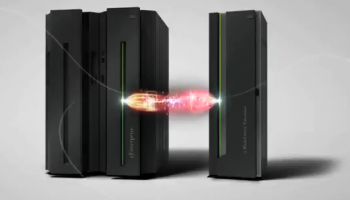Windows For IBM System z Mainframes This Year

IBM will launch blade servers running Windows on its zEnterprise mainframes by the end of this year
IBM has announced that it will provide support for blade servers running Windows on IBM zEnterprise mainframes as early as the end of 2011.
In an April 12 announcement to its EMEA (Europe, Middle East and Africa) hardware clients, IBM said it would support System x blades running Windows on zEnterprise systems in the fourth quarter of 2011.
Upon announcing its new mainframes in July 2010, IBM introduced a new dimension in computing with the IBM zEnterprise Server, as it enables users to deploy an integrated hardware platform that brings mainframe and distributed technologies together. IBM described it as a system that can start to replace individual islands of computing and can work to reduce complexity, lower costs, improve security and bring applications closer to the data they need.
Responding To Customer Demands
 As part of that announcement, IBM provided a road map for its hybrid capabilities, the delivery of special-purpose workload optimisers and select general-purpose IBM blades. In 2010 IBM delivered a business analytics solution – IBM Smart Analytics Optimizer – and then general-purpose Power7 blades.
As part of that announcement, IBM provided a road map for its hybrid capabilities, the delivery of special-purpose workload optimisers and select general-purpose IBM blades. In 2010 IBM delivered a business analytics solution – IBM Smart Analytics Optimizer – and then general-purpose Power7 blades.
In February 2011, IBM continued with the announcement of the IBM WebSphere DataPower XI50 for zEnterprise (DataPower XI50z), a multifunctional appliance for the System z environment that can be implemented to help provide X M L hardware acceleration, and to streamline and secure valuable SOA (service-oriented architecture) applications.
Now, in the next step of its road map, IBM is moving to incorporate select IBM System x technologies, originally targeted for the first half of 2011.
In a statement to its EMEA base, IBM asserted: “The reaction to delivering IBM System x capabilities has been very positive, with our clients also asking that we support Microsoft Windows. Therefore, today we are revising our road map to include planned support for Windows on System x as well as a revised schedule for IBM System x blade delivery on the IBM zEnterprise Systems.”
Specifically, IBM said:
- In the third quarter of 2011, IBM intends to offer select IBM System x blades running Linux on System x in the IBM zEnterprise BladeCenter Extension Model 002.
- In the fourth quarter of 2011, IBM intends to offer select IBM System x blades running Microsoft Windows in the IBM zEnterprise BladeCenter Extension Model 002.
In a piece in the Pund-IT Review discussing the IBM news, Wayne Kernochan, president of Infostructure Associates, referred to IBM’s planned Windows support as “big news”.
Kernochan noted that IBM’s Windows support “won’t arrive until 4Q 2011″. He said it will involve only the blade side of zBX (Windows virtual machines running on specific System x-type blades) and the umbrella zBX virtual-server/storage/network admin tool Unified Resource Manager (URM).
Full support of application-level administration and load balancing for Windows platforms is not yet in the IBM roadmap. This does not mean that IBM’s planned support for Windows on zEnterprise is incomplete.
“On the contrary,” Kernochan argued, IBM has applied its usual combination of strong technology and services to allow users to implement IBM System x blades running Windows that integrate seamlessly into the overall zEnterprise solution.”
He also believes IBM’s plans to support Windows on the mainframe is as important as its plans regarding cloud computing, Integrated Service Management and analytics. That means Kernochan views this Windows strategy as a significant move by IBM, as the company’s chief financial officer, Mark Loughridge, has said IBM expects to see $7 billion (£4.2 billion) in revenue from cloud computing by 2015.
“I agree with much of what Wayne says,” said Charles King, president of Pund-IT. “Even though the management tool set – IBM’s URM or zManager solution – won’t initially extend entirely across Windows, the ability to support Windows-based blades on the zBX offers enterprises a valuable new way to consolidate their Microsoft assets. As the IBM solution matures, I believe mainframe/Windows customers will find its value continuing to grow over time.”
Yet, Kernochan envisages an even bigger world of interoperability where IBM offers Windows plus Linux plus z/OS support. Of this, Kernochan said:
“Why does full Windows/Linux/z/OS integration, as opposed to IBM’s road map today, matter? First, because Windows, Linux, and z/OS on the mainframe are the lion’s share of large organisations’ most important platforms, with most enterprises using all three.
“If we can imitate enough of Windows on Linux or on Linux-supporting blades, we can move most Windows apps to scale-up servers when needed (Unix/Linux and/or mainframe),” he continued. “So we will have achieved source-code compatibility from Windows to Linux, Java real-time portability from Linux to Windows, source-code compatibility for most Windows apps from Windows to Linux on the mainframe, and Linux source-code compatibility and Java real-time portability from Linux to the mainframe and back.”